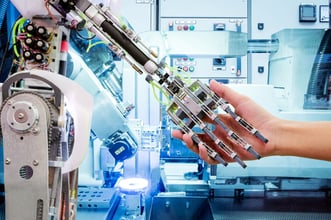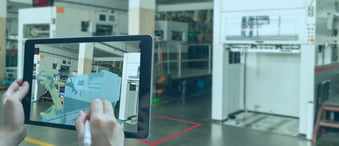Technology and the manufacturing industry have always worked hand in hand. Recently, however, rapid technological innovation and the Internet have fuelled the ongoing industrial revolution in 2020 where robotic automation is expected to expand its role and impact in various manufacturing settings.
 Robotic process automation (RPA), in particular, is already making waves and is predicted to be more widely adopted in industries where its virtues have a high degree of applicability. This is especially true for industries where a range of manual repetitive actions are currently being performed by humans. However, manufacturers looking to automate or that are poised to undergo digital transformation will need to conduct due diligence and analyses to ensure which technologies and tools are appropriate to their operations.
Robotic process automation (RPA), in particular, is already making waves and is predicted to be more widely adopted in industries where its virtues have a high degree of applicability. This is especially true for industries where a range of manual repetitive actions are currently being performed by humans. However, manufacturers looking to automate or that are poised to undergo digital transformation will need to conduct due diligence and analyses to ensure which technologies and tools are appropriate to their operations.
Here is some key information about the most promising manufacturing technologies likely to have the greatest influence on business in the near future, along with their benefits. Once your business is aware of these innovations, you can make vital decisions about whether or not they are right to adopt for your enterprise.
Key benefits of new technologies
It’s no secret that the manufacturing sector has been one of the primary beneficiaries of innovative technologies that have arrived and continue to undergo changes and improvements with the passage of time. These technologies have benefited the manufacturing sector (and continue to do so) in the following ways:
- Cost savings, increased output and profitability: Automating repetitive processes saves manufacturers both time and money and ensures production is on track so the business remains profitable. It also helps improve employee wellbeing and allows companies to utilise human resources for higher level, creative tasks.
- Reduction in downtime: Investing in predictive maintenance greatly reduces the possibility of downtime which can lead to losses in the bottom line and customers.
- Higher level of competitiveness: Manufacturers that have invested in and harness the benefits offered by new technologies experience more growth compared with those that continue to run on legacy systems that are no longer compatible with the needs of the times.

- Increased business system efficiency: An excellent example of this advantage is the introduction of cloud-based platforms that allow businesses and their data assets to remain unified and accessible across various geographies and time zones. Cloud technology has given manufacturers and other business a high level of agility, scalability, accessibility and security previously unheard of. It has enabled manufacturers to focus on growth, business streamlining and improving process efficiency, as well as save on what could be substantial investments in data storage, management and security services.
- Streamlined supplier and customer relationships: The availability of business enterprise software has enabled manufacturers and other companies to simplify and support various business processes, manage and safeguard information, control reporting, conduct complex data analytics and manage supplier and customer relationships, among other things. Aside from enterprise resource planning (ERP) systems, companies have access to enterprise planning and customer relationship management software. Moreover, the Internet of Things (IoT) and artificial intelligence (AI) have also helped streamline communications between customers and manufacturers. This way, updates are done remotely in real time, and customers can be informed about potential product defects and enhancements easily.
- Higher levels of efficiency, speed and flexibility in production: Most industries today have globalised operations and serve an international market, which is why technologies such as RPA and predictive maintenance have been adopted and are expected to grow further as these are designed to enhance productivity and reduce manufacturing downtimes.
- Product range expansion: The availability of data analytics allows manufacturers to gain valuable insights about their own operations as well as customer behaviour. With data insights, manufacturers learn to address previously unrecognised needs of customers, thereby effectively increasing the range of the products they offer. Data analytics also enables machine operators and programmers to configure equipment to make autonomous decisions and utilise predictive behaviour based on data to enhance efficiency. In fact, it is analytics and manufacturing intelligence together that drive machine learning to come up with prescriptive actions that save valuable time and energy which, in turn, are a critical component in the business strategy of manufacturers today.
- More efficient collaboration and knowledge sharing: The fast and easy access to information in the digital realm has made it possible for manufacturers to transform and scale to better respond to the needs of their customers, as well as improve data security, operations and other aspects of their business.
Of course, there are other ways which new technologies have benefited and will continue to benefit the manufacturing sector, which is why it is critical to adopt appropriate tech innovations as they happen to remain competitive.
Emerging technologies in manufacturing
Among the newer and emerging technologies that are expected to influence the growth of the manufacturing sector include the following:
- Advanced robotics and automation: Although human capabilities can handle different levels of strain, advanced robotics and automation technology provide a faster, more systematic and efficient means of production.
- Growing need for 5G: To remain highly competitive, manufacturers will need to adopt faster 5G networks that will enable them to build smart factories and better adopt new technologies such as robotics, automation, IoT and augmented reality (AR) for troubleshooting purposes.

- Predictive maintenance: Manufacturers that have adopted predictive maintenance can effectively avoid the costs and losses associated with unscheduled downtimes. Through the intensive use of data analytics, identified patterns in machine operations are used to predict potential problems and failures. These can then be addressed or resolved right away, so that equipment breakdowns are minimised and asset lifetimes are optimised in the process.
- Advanced manufacturing: Through the use of innovative processes and technologies, manufacturers can make intelligent decisions based on real-time, actionable and date, and remain responsive to the needs of their markets.
- 3D printing: Also known as “Additive manufacturing,” 3D printing has significantly helped reduce lead time and streamlined the process of design to production. It has also enabled manufacturers to create various components using different materials with a high degree of design accuracy.
- Internet of Things (IoT) and Industrial Internet of Things (IIoT): Both the IoT and IIoT have already begun transforming manufacturing processes today as they address the high demand for product customisation. This enables manufacturers to create products that are tailored to satisfy customer expectations. These applications also allow for improved asset management, as the interconnectivity of everything enables manufacturers to track, manage inventory and implement preventive maintenance.
- Simulation software: The use of simulation in manufacturing systems involves computer modelling or configurations of these setups. Doing so enables users to make analyses and obtain critical information that can help with investment risk reduction, minimising waste, inventory reduction and improving efficiency. Plant simulations have also been proven to be specifically beneficial for manufacturers considering the adoption of a new advanced planning and scheduling (APS) or ERP system.
The aforementioned technologies only cover part of the technological developments that have changed the course of manufacturing. There are others worth considering depending on the type of manufacturing operation involved. Moreover, other technologies are expected to emerge as older technology continually undergoes further study, analysis and improvement.
Invest in the future
 Martin Thomas, European Marketing Manager at Radwell International says, "It’s a widely known fact that the manufacturing sector has benefited greatly from the continuous adoption of new technologies. However, there are still those who have yet to embrace their benefits and discover the possibilities that new and emerging technologies promise.
Martin Thomas, European Marketing Manager at Radwell International says, "It’s a widely known fact that the manufacturing sector has benefited greatly from the continuous adoption of new technologies. However, there are still those who have yet to embrace their benefits and discover the possibilities that new and emerging technologies promise.
While the acquisition of these technologies may require a significant investment on the part of manufacturers, in time, the benefits to be had can easily outweigh the initial costs."
Written by Radwell International Ltd. Radwell is a global leader in MRO and industrial automation parts and repair services, recognised as the world’s largest stockist, with an inventory of over 20 million products.









